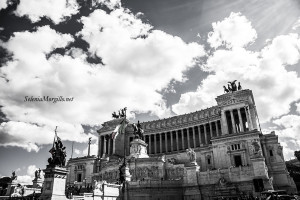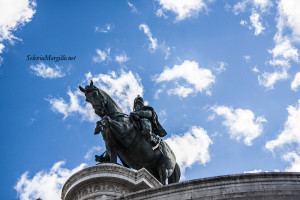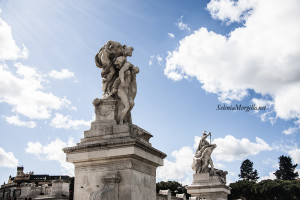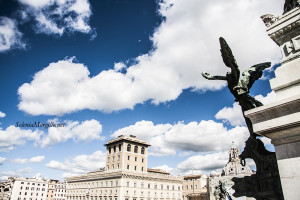Vittoriano or Wedding Cake!
Italian Version Below*
For some, it is known as Vittoriano for others as Altare Della Patria and foreigners who arrive in Rome read on the guides of a huge “wedding cake” in the city center!
What a mess!
On the death of Vittorio Emanuele II, which took place on 9 January 1878, the government and public opinion mobilized to carry out a project that paid homage to the first King of Italy.
On June 24, 1884, following a controversial competition, Giuseppe Sacconi’s project was chosen, which followed the work until 1905, the year of his death. He was later replaced by a group of three architects G. Koch, Pio Piacentini, and Manfredo Manfredi.
A first partial inauguration took place in 1911; the “infinite” works ended only in 1935.
The first idea of a monument that paid homage to the King of Italy was also joined by that of the “Unknown Soldier” chosen from 11 corpses of “unknown” soldiers who died during the First World War.
The monument was built entirely in Botticino Marble and in addition to the team of architects, several sculptors were chosen for the decorations, among which we remember: the Thought of Giulio Monteverde, the Action of Francesco Jerace, the Force of Augusto Rivalta and the Right to Ettore Ximenes.
The entire decoration is clearly explained by the inscriptions in the two propylaea which close the structure at the top: underlying them Patriae Unitati and Civium Libertati or the unity of the homeland and the freedom of citizens!
The Vittoriano with its shapes recalls the altar of Pergamum (preserved in Berlin), the Sanctuary of Fortuna Primigenia of ancient Praeneste (today Palestrina – Lazio), the Temple of Hercules in the small town of Cori (province of Latina) to which surely Sacconi looked.
Inside the structure, there are the Museum of the Risorgimento and the Museum of Emigration.
The tourist also has two panoramic lifts available to reach the terraces and enjoy a wonderful view of Rome!
The elevators are paid …… If you want breathtaking “free” views of the eternal city you can reach the Janiculum, the Orange Garden (Aventino), or the Terrazza del Pincio (Piazza del Popolo).
Info: HERE
Per alcuni è noto come Vittoriano per altri come Altare della Patria e gli stranieri che arrivano a Roma leggono sulle guide di un’enorme “wedding cake” in pieno centro cittadino!
Che confusione!
Alla morte di Vittorio Emanuele II, avvenuta il 9 Gennaio 1878, il governo e l’opinione pubblica si mobilitarono per realizzare un progetto che omaggiasse il primo Re d’Italia.
Il 24 Giugno 1884 venne scelto, a seguito di un controverso concorso, il progetto di Giuseppe Sacconi che seguì i lavori fino al 1905, anno della sua morte. Fu poi sostituito da un gruppo di tre architetti G. Koch, Pio Piacentino e Manfredo Manfredi.
Una prima parziale inaugurazione si ebbe nel 1911; i lavori “infiniti” terminarono solo nel 1935.
Alla prima idea di un monumento che omaggiasse il Re d’Italia si unì anche quella del “Milite Ignoto” scelto tra 11 salme di soldati “sconosciuti”morti durante la Prima Guerra Mondiale.
Il monumento fu realizzato interamente in Marmo Botticino ed oltre al team degli architetti, furono scelti diversi scultori per le decorazioni, tra cui si ricordano: il Pensiero di Giulio Monteverde, l’Azione di Francesco Jerace, La Forza di Augusto Rivalta e il Diritto di Ettore Ximenes.
Il filo conduttore dell’intera decorazione è chiaramente esplicitato dalle iscrizioni nei due propilei che chiudono in alto la struttura: Patriae Unitati e Civium Libertati ovvero all’unità della patria ed alla libertà dei cittadini!
Il Vittoriano con le sue forme richiama l’Altare di Pergamo (conservato a Berlino), il Santuario della Fortuna Primigenia dell’antica Praeneste (oggi Palestrina – Lazio), il Tempio di Ercole nella piccola cittadina di Cori (provincia di Latina) a cui sicuramente Sacconi guardò.
All’interno della struttura sono presenti il Museo del Risorgimento ed il Museo dell’Emigrazione.
Il turista ha a disposizione anche due ascensori panoramici per raggiungere le terrazze e godere di una vista meravigliosa su Roma!
Gli ascensori sono a pagamento…… Se desiderate viste “gratuite” mozzafiato sulla città eterna potete raggiungere il Gianicolo, il Giardino degli Aranci (Aventino) o la Terrazza del Pincio (Piazza del Popolo).
Info: QUI
Sostieni #laculturachevince, aiuta la condivisione.



